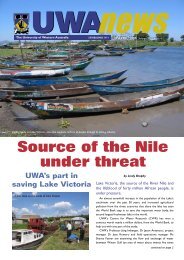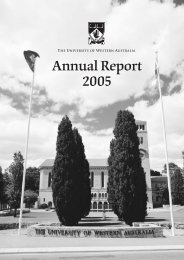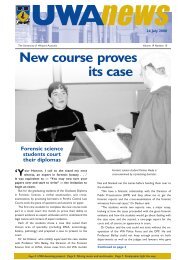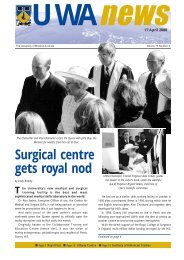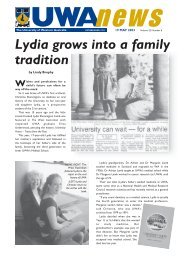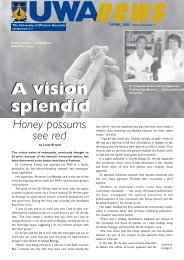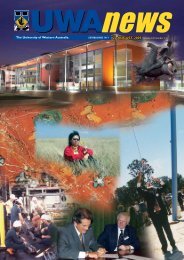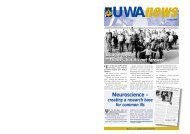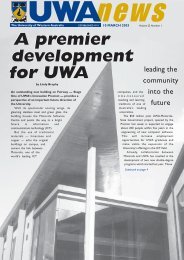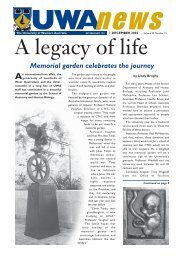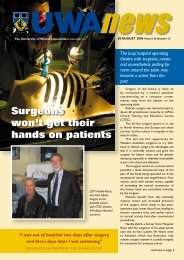news August 9 WEB - UWA News staff magazine - The University of ...
news August 9 WEB - UWA News staff magazine - The University of ...
news August 9 WEB - UWA News staff magazine - The University of ...
- No tags were found...
You also want an ePaper? Increase the reach of your titles
YUMPU automatically turns print PDFs into web optimized ePapers that Google loves.
<strong>UWA</strong><strong>news</strong><strong>The</strong> <strong>University</strong> <strong>of</strong> Western Australia ESTABLISHED 1911 9 AUGUST 2004 Volume 23 Number 11Birth can heraldpotential killerBig US grant to study breast cancerby Lindy BrophyPregnancy, while a time <strong>of</strong> joy for most expectant mothers,leaves a woman’s body vulnerable, and many cancers arediagnosed during pregnancy or immediately after birth.Pr<strong>of</strong>essor Christobel Saunders, Pr<strong>of</strong>essor <strong>of</strong> Surgical Oncology in the School <strong>of</strong>Surgery and Pathology, has won significant funding from a United States cancerresearch foundation to gain a greater understanding <strong>of</strong> breast cancers thatoccur during pregnancy.She and her team will use WA’s extensive and unique populationdata for the study, funded by the Susan G Komen foundation, for$US240,000. <strong>The</strong>y also have funding from the WA ClinicalOncology Group.Pr<strong>of</strong>essor Saunders said that <strong>UWA</strong> researchers werecurrently studying breast cancer from many perspectives andtheir work was attracting international funding because <strong>of</strong> itshigh quality, and because <strong>of</strong> the availability <strong>of</strong> detailedpopulation health data from the WA Data Linkage System,jointly managed by the WA Department <strong>of</strong> Health and<strong>UWA</strong>’s School <strong>of</strong> Population Health.“We have found in a study, funded by the RaineFoundation, that breast cancer associated with apregnancy is diagnosed in about seven percent <strong>of</strong> youngwomen, and that four percent <strong>of</strong> women who havesurvived breast cancer will go on to get pregnant,”Pr<strong>of</strong>essor Saunders said.“However, diagnosis and treatment become moredifficult because <strong>of</strong> the pregnancy, and we need a much betterunderstanding <strong>of</strong> how pregnancy affects a breast cancer andhow a cancer will affect a woman’s pregnancy.“We have already done a lot <strong>of</strong> research on gestational breastcancer and are now planning to extend this work to look at, forexample, the imaging and pathology <strong>of</strong> these cancers, and thepsychosocial issues encountered by these women. We will also beextending the study to look at all young WA breast cancer patients, whichwill be both an invaluable comparator group and give us important informationon patterns <strong>of</strong> care.”<strong>The</strong> study is a collaborative project involving Dr James Semmens and Angela Ivesfrom the School <strong>of</strong> Population Health, and Associate Pr<strong>of</strong>essor Kate White from EdithCowan <strong>University</strong>. Pr<strong>of</strong>essor Saunders says that the good <strong>news</strong> is that while fertility can besignificantly reduced by cancer treatment, young women who have had breast cancer can goon to have successful pregnancies that are cancer-free.
2 <strong>UWA</strong><strong>news</strong>Makingchanges forbabies oncampus<strong>The</strong> <strong>University</strong>’s policy <strong>of</strong>supporting its <strong>staff</strong>’s worklifebalance has a newpractical focus.For <strong>staff</strong> and students whose familyresponsibilities include the care <strong>of</strong>babies, several new baby changingfacilities are being installed on campusover the next few months.Gaye McMath, Executive Director,Finance and Resources, said theinstallation <strong>of</strong> the changing tables inunisex toilets had been an agreedaction at <strong>UWA</strong> for a few years. <strong>The</strong>yhad been built in at the Oral HealthCentre <strong>of</strong> WA (OHCWA), and areplanned for the new <strong>University</strong> Cluband the Molecular Sciences building.Ms Mc Math said that if creating thebest work-life balance for some <strong>staff</strong> andstudents meant bringing a child ontocampus, then it was the responsibility <strong>of</strong>the <strong>University</strong> to assist them.<strong>The</strong> <strong>University</strong> already has changetables at the medical/dental library,OHCWA, the Child Study Centre andparenting facilities at the Guild and the<strong>UWA</strong> Medical Centre.<strong>The</strong> <strong>of</strong>fice <strong>of</strong> Facilities Managementhas committed to installing anadditional five facilities this year and toensure that all new constructionsprovide baby change tables in unisextoilets. OFM has identified a need inthe following areas, where facilitiesare soon to be installed: SocialSciences building, Arts building, GuildVillage, Centre for Water Researchand the School <strong>of</strong> Architecture,Landscape and Visual Arts.OFM’s Gerald Stack said the tableswere prefabricated and folded upagainst a wall when not in use. Alltables have straps to prevent wrigglingbabies from falling <strong>of</strong>f. “All the newchange tables will be on the groundfloor, some <strong>of</strong> them in existingdisabled toilets, because they havemore room, and some in femaletoilets,” he said.Books for kidsmilestoneVice-Chancellor Pr<strong>of</strong>essor Alan Robson cut the anniversary cake with the help <strong>of</strong>Jan White (left), President <strong>of</strong> the <strong>University</strong> branch and Kay Hallahan, National Chair <strong>of</strong> SCF<strong>The</strong> <strong>University</strong> branch <strong>of</strong> Save the Children Fund (SCF)celebrated the 40th anniversary <strong>of</strong> their book sale with theirbiggest pr<strong>of</strong>it ever.<strong>The</strong> proceeds <strong>of</strong> the sale, in the Undercr<strong>of</strong>t last month, were $127,000, topping lastyear’s total by just $1,000. <strong>The</strong>y also celebrated with a cake, cut by the Vice-Chancellor the day before the sale opened to thousands <strong>of</strong> Perth booklovers.<strong>The</strong> funds from the sale will be used to support SCF’s projects overseas as well as arange <strong>of</strong> health and welfare projects for children in Perth city, the hills, the wheatbeltand Carnarvon.On behalf <strong>of</strong> the branch, Rosalind Lindsay thanked the sale’s supporters for boththeir patronage and donations.<strong>UWA</strong><strong>news</strong>EDITOR/WRITER Lindy BrophyTel.: 6488 2436 Fax: 6488 1192 Email: lindy.brophy@uwa.edu.auEDITOR-IN-CHIEF Colin Campbell-FraserTel: 6488 2889 Fax: 6488 1020 Email: ccampbell@admin.uwa.edu.auDesigned and typeset by Publications Unit, <strong>UWA</strong>Printed by UniPrint, <strong>UWA</strong><strong>UWA</strong><strong>news</strong> online: www.publishing.uwa.edu.au/uwa<strong>news</strong>/THE UNIVERSITY OF WESTERN AUSTRALIA • 9 AUGUST 2004
countdown<strong>UWA</strong><strong>news</strong> 3EXPOAustralian Idol hopefuls who weredisappointed at the local auditions cantry again at EXPO.<strong>The</strong> Arts Faculty’s Multimedia Centre is invitingvisitors to the annual open day to perform in ArtsstralianIdol and go home with their talent captured ona CD.Others may be more interested in a display by theBusiness School on the economics <strong>of</strong> the marijuanamarket.Musicians will be intrigued by an optical pickup for aguitar, being demonstrated by the School <strong>of</strong> Electricaland Electronic and Computer Engineering.Or you can try out the eddy current can crusher atPhysics, have a personality reading at Psychology orget a nano-view <strong>of</strong> your household in Microscopy.Dozens <strong>of</strong> <strong>staff</strong> have been working for the past fewmonths to get EXPO ready for Sunday <strong>August</strong> 29, andall <strong>staff</strong> are encouraged to help out over the nextthree weeks and to come along on the day.<strong>The</strong> popular information sessions for prospectivestudents, both undergraduate and graduate, will berun, and repeated, during the day. Other favouritesfrom previous EXPOs will be the helicopter rides fromJames Oval; free tram rides around the campus; theChemistry magic show (usually standing room only);the opportunity to climb up Winthrop Tower (usingthe stairs inside, rather than ropes on the outside!);learn-to-suture sessions at Anatomy for buddingsurgeons; wine to taste and animals to handle,courtesy <strong>of</strong> Natural and Agricultural Sciences; andSport and Recreation’s climbing wall.A full program for EXPO will be published in <strong>The</strong>West Australian on Saturday <strong>August</strong> 21, so make sureyour family, friends and neighbours get their copiesand encourage them to come along and see whatreally happens on campus.For more information visit theEXPO website:www.expo.uwa.edu.auTHE UNIVERSITY OF WESTERN AUSTRALIA • 9 AUGUST 2004
column4 <strong>UWA</strong><strong>news</strong>Vice-Chancellor’s<strong>The</strong>challengeStatisticallythe bestthe<strong>of</strong>reward &work at <strong>UWA</strong>It was pleasing to see a table recently published in <strong>The</strong> Australian<strong>news</strong>paper which showed that <strong>UWA</strong> had the lowest ‘<strong>University</strong>student-to-teacher ratio’ <strong>of</strong> all WA universities and was secondonly to UNSW nation-wide.It is worthy <strong>of</strong> note as it comes at a time when we are looking at the implications <strong>of</strong>the 2003 Working Life Survey, and at ways in which <strong>UWA</strong> can better support <strong>staff</strong> inachieving a balance between their working and non-working lives.<strong>The</strong> Working Life survey showed workload as the number one concern for most <strong>staff</strong>.Factors creating workload pressure are many and varied, but are something we need toattend to. <strong>The</strong> surveys conducted in 1997 and 2000 both provided a valuable insight into theviews, perceptions and experiences <strong>of</strong> <strong>staff</strong> and has been useful for planning purposes,particularly in relation to enterprise bargaining.It is the understanding that salaries are just one component <strong>of</strong> employmentconditions <strong>of</strong>fered to <strong>staff</strong> that we have brought to our discussions around the nextEnterprise Bargaining Agreement. We believe the total package <strong>of</strong> working conditionsat <strong>UWA</strong> is valued overall by <strong>staff</strong>. It includes a flexible Academic Promotion System,free <strong>of</strong> quotas or restrictions; salary progression for general <strong>staff</strong> (now under reviewwith a view to facilitating application <strong>of</strong> superannuation to salary progressionallowances); flexible working arrangements aimed at promoting work/life balance;flexible and generous study leave provisions for academic <strong>staff</strong> which provide for accessto six months leave after three years service or one year after six years service; anemployment philosophy promoting direct employment <strong>of</strong> <strong>staff</strong> on a tenurable/tenuredor ongoing basis; and provision <strong>of</strong> in house childcare facilities and a commitment toincrease these facilities.Salary is certainly a motivator for <strong>staff</strong> but is not <strong>of</strong> itself the sole reason peoplechoose to work at the <strong>University</strong> and it can be <strong>of</strong>fset by the other elements as outlined.In attending to the challenge <strong>of</strong> reducing workload pressure, the most pressing concernis how we deal with the competing priorities <strong>of</strong> compliance with <strong>University</strong>-wideinitiatives and expectations placed on us both collectively and individually within anincreasingly competitive external framework as well as our day to day internal activities.As a start we have limited the number <strong>of</strong> emails to all <strong>staff</strong>, and are investing constantly inanti-spam programs, to screen out the huge volumes that arrive daily. We are alsoattempting to shield <strong>staff</strong> from the seemingly ever-increasing reporting requirements fromDEST and other Government agencies. Unfortunately some <strong>of</strong> these fall under the ‘noreport, no funding’ category. We are asking <strong>staff</strong> for suggestions on how to reduceadministrative workloads, and some very useful proposals have now come forward forconsideration from the <strong>University</strong> Managers Group. Exploring this issue further is achallenge we face together.Alan Robson Vice-ChancellorPr<strong>of</strong>essor Adrian Baddeley, a world leader inhis area <strong>of</strong> mathematics and statisticsAs one <strong>of</strong> the world’s greatstatisticians, Pr<strong>of</strong>essor AdrianBaddeley can probably workout the probability <strong>of</strong> winningthe Pitman Medal.<strong>The</strong> Medal is the highest honour thatcan be bestowed by the StatisticalSociety <strong>of</strong> Australia (SSA), and it waspresented to Pr<strong>of</strong>essor Baddeleyrecently. It is awarded for achieving highdistinction in statistics, which enhancesthe international standing <strong>of</strong> Australia inthis discipline.<strong>The</strong> following extract is from the SSAassessors’ report: “Adrian Baddeley is aworld leader in the areas <strong>of</strong>mathematical stereology, stochasticgeometry, and spatial statistics. Hispapers have invariably been seminal,ranging from highly useful and innovativecreations <strong>of</strong> new sampling techniques instereology, through to novel statisticaldiagnostics for point patterns, andemploying both pr<strong>of</strong>ound mathematicsand also implementation as practicalcomputer methods.”Associate Pr<strong>of</strong>essor Tony Pakes,Head <strong>of</strong> the School <strong>of</strong> Mathematics andStatistics, congratulated Pr<strong>of</strong>essorBaddeley on “this wonderful recognition<strong>of</strong> his scientific work.”THE UNIVERSITY OF WESTERN AUSTRALIA • 9 AUGUST 2004
<strong>UWA</strong><strong>news</strong> 5Damian Davini with histeam mates and teammanager, after winningthe national awardDamien’s number 1in first aidby Maureen de la Harpe<strong>The</strong>y couldn’t be more different: IT with itsemphasis on precise systems and itsdependence on technology; and first aid, inwhich you are dealing with critical situations,injuries and sometimes human lives.Damian Davini is an IT systems manager, currently workingon a project in Financial Services. Since the age <strong>of</strong> eleven he hasalso been a committed volunteer ‘first aider’ with St JohnAmbulance. And last month he became a national championwhen his team <strong>of</strong> three won the annual National First AidCompetition.“I’ve represented WA numerous times,” says Damian, “butthis is the first time I’ve won a national award.”Alice Springs was the venue for the finals, which broughttogether winning teams from around Australia. Damian’s team<strong>of</strong> volunteers (they trained twice weekly for the event)competed against nurses and paramedics for whom first aid ispart <strong>of</strong> the job rather than a voluntary activity.<strong>The</strong> finals took the form <strong>of</strong> a mock scenario in which the‘first aiders’ had to put their training into practice in a criticalsituation. In this case, it was a parachute accident: a parachutisthad landed in a tree, dislodging branches that had fallen onbystanders, causing multiple casualties.<strong>The</strong> event was held on a Saturday morning in the CivicCentre gardens in Alice Springs’ town centre and thecompetition was watched by a large, fascinated audience. <strong>The</strong>accident scene is always staged very realistically, according toDamian. “We arrive on the scene and in a set time we have tocontrol the situation, treat the casualties, and arrange theirtransport to hospital or discharge them. Marks are given forevery aspect <strong>of</strong> the event: how well we treat the casualties, howquickly and how effectively.”Competing in such realistic situations is very stressful, saysDamian, “because you want to do well, you put highexpectations on yourself, and you are dealing with situationsyou don’t normally meet at a sporting event or concert.”He became interested in first aid through his mother whowas a member <strong>of</strong> St John. He joined up while still at primaryschool and has been working for the organisation ever since. AsDivisional Manager <strong>of</strong> St John’s Mundaring branch, whichinvolves weekly training and public first aid duties, he especiallyenjoys being on duty at public events.“You get to go to big sporting occasions and concerts — Iwas lucky enough to go the Sydney Olympics in 2000. It’s a bigselling point when we recruit new members.”Damian’s Team Manager Gabrielle West is delighted with theteam’s success.“I’m extremely proud <strong>of</strong> the entire team, especially as I’veseen all the training they put in. It’s nice to see that their hardwork paid <strong>of</strong>f,” she said.While winning national competitions is exciting, what givesDamian enduring satisfaction are the more routine aspects <strong>of</strong>his St John activities, which add up to a commitment <strong>of</strong> about100 hours a year.“Keeping up with your training and doing public first aidduties is satisfying because you are able to help people andknow that you are making a difference to them.”THE UNIVERSITY OF WESTERN AUSTRALIA • 9 AUGUST 2004
6 <strong>UWA</strong><strong>news</strong>Preserving theancienthistory<strong>of</strong> theMiddle East“<strong>The</strong> Middle East is a treasure trovewaiting to be discoveredand explored”THE UNIVERSITY OF WESTERN AUSTRALIA • 9 AUGUST 2004
<strong>UWA</strong><strong>news</strong> 7David Kennedy has spent more timeflying over ancient ruins in Jordan thanbrowsing the aisles <strong>of</strong> his local supermarket.And, as it’s infinitely more exciting than perusing grocerieson shelves, Pr<strong>of</strong>essor Kennedy is sharing his experiences <strong>of</strong>aerial archaeology with the community — through two books, apublic lecture, a <strong>UWA</strong> Extension course, and a guided tour <strong>of</strong>Roman Jordan.<strong>The</strong> Pr<strong>of</strong>essor <strong>of</strong> Ancient History and Roman Archaeologyhas been regularly visiting the Middle East since 1969, workingin Jordan since 1976, and flying over Jordan every year since1997, with the support <strong>of</strong> the Jordanian royal family.Together with Dr Robert Bewley (co-author <strong>of</strong> one <strong>of</strong> hisbooks), Head <strong>of</strong> Survey for English Heritage, and FrancescaRadcliffe, a freelance aerial archaeologist, Pr<strong>of</strong>essor Kennedyhas taken about 10,000 aerial photographs in these nineseasons.“It is a major and vital task to record the archaeology beforeit is swept aside by rapid development, and to monitor sitesunder threat,” Pr<strong>of</strong>essor Kennedy said. “A classic example isthe town <strong>of</strong> Ma’an, famous from the battles <strong>of</strong> the Arab Revolt<strong>of</strong> WWI. <strong>The</strong> traces are still visible, all around, <strong>of</strong> the Turkishtrenches, but they are starting to be filled in, after 85 years <strong>of</strong>preservation.“Nearby, in 1998, we photographed a superb caravanserai,<strong>of</strong>, perhaps, the eighth century AD, about 40 metres square. In2000, it had had all the internal rooms bulldozed away. By 2003,it was bulldozed entirely.”Roman ruins are Pr<strong>of</strong>essor Kennedy’s specialty. He has ledtwo guided tours <strong>of</strong> Roman Britain and is leading a tour <strong>of</strong>Roman Jordan next year. He has just spent his study leavetracing more Roman ruins across the deserts <strong>of</strong> Jordan.“Jordan is terribly underexposed, compared with the ruins inwestern Europe,” he said. “<strong>The</strong> Middle East is a treasure trovewaiting to be discovered and explored. <strong>The</strong>re are only about 15archaeologists working on the Roman period in Jordan, whilethere are up to 60 in Britain just working on Hadrian’s Wall!.”He said that, despite the royal family’s support <strong>of</strong> his aerialarchaeology, there were too few safeguards for preservingimportant sites. “Each year, when I go back, I can see sites that Iphotographed have gone, been bulldozed to make way forroads and development.”David Kennedy, Francesca Radclifffe, Bob Bewley andRoyal Jordanian Air Force crew before a recent helicopter flightover Roman ruins (see pic below)Pr<strong>of</strong>essor Kennedy said he always felt safe in Jordan. “<strong>The</strong>Middle East has a bad reputation. I feel safer in Jordan at nightthan I do here or in Britain. <strong>The</strong> people are so hospitable that,sometimes, it’s hard to get your work done!”His new book (with Bob Bewley), Ancient Jordan from the Air,is a cross between an academic publication and c<strong>of</strong>fee tablebook. While there are no footnotes, its 60,000 words <strong>of</strong> textmake it more than just a book to browse casually, but its 200photographs should make it more popular than an academictome. “Certainly the print run <strong>of</strong> 3,000 copies implies weexpect four or five times the sales figures an academic booknormally gets in my field,” he said.<strong>The</strong> second edition <strong>of</strong> his earlier book <strong>The</strong> Roman Army inJordan, has also recently been published. <strong>The</strong> first edition soldout in a year. Both books are published by the Council forBritish Research in the Levant/British Academy.On Wednesday <strong>August</strong> 18, Pr<strong>of</strong>essor Kennedy is delivering apublic lecture, Ancient Jordan from the Air, illustrated with many<strong>of</strong> his thousands <strong>of</strong> photographs. He hopes both the lecture andthe book will inspire people to join his guided tour <strong>of</strong> Jordan inlate April, early May next year. <strong>The</strong> tour will include two weeksin Jordan, including the ‘rose-red’ city <strong>of</strong> Petra, and a week inSyria, with a visit to Palmyra, and a possible side trip to Baalbekin the Lebanon.Overlapping with the public lecture, Pr<strong>of</strong>essor Kennedy willpresent a course for <strong>UWA</strong> Extension beginning on Thursday<strong>August</strong> 5 on Petra, the Nabataeans and the Roman Empire, bothon the <strong>UWA</strong> campus and at venue in Kalamunda.A busy year lies ahead. In September he is <strong>of</strong>f to <strong>The</strong>Institute for Advanced Study in Princeton for three months; hehas just been elected to a Cotton Fellowship for 2004/5 whichwill provide some support for his fieldwork in Jordan in early2005 and he expects to lead the tour <strong>of</strong> Jordan and Syria soonafter.Information about the tour <strong>of</strong> Jordancan be found at:http://www.arts.uwa.edu.au/Classics/Jordanair.htmhttp://www.extension.uwa.edu.au/tours/jordan.shtmlTHE UNIVERSITY OF WESTERN AUSTRALIA • 9 AUGUST 2004
8 <strong>UWA</strong><strong>news</strong>A classiccareer comesto a closeWhen Margrit Walmsley firststarted work at <strong>UWA</strong> in1969, she was thrilled to haveher first electric typewriter.“I used to type 99 words a minute. Iknow, because, in those days,secretaries were paid an allowance inaccordance with their typing speed.Every year, our typewriters would betaken to Mount Lawley tech, and wewould have to go there on a Saturdaymorning and do a test,” she said.Margrit, administrative assistant inClassics and Ancient History, is retiringon <strong>August</strong> 20, just three weeks short <strong>of</strong>35 years at <strong>UWA</strong>.She has a very good reason to beleaving just before reaching themilestone. Margrit is taking herhusband, daughter, son-in-law and twogranddaughters to India for celebrationsmarking her old school’s 150 thanniversary.“I was in the centenary class atWoodstock, which is now called <strong>The</strong>International School,” she said. “Mymother was English and my father wasSwiss, but I was born in Calcutta andboarded at Woodstock for all <strong>of</strong> myschool life. My father was working for aSwiss company in India, but in thosedays, all the expats sent their childrento school in the foothills <strong>of</strong> theHimalayas, because it was cooler than inthe cities down south.“Woodstock was in one <strong>of</strong> the hillstations and most <strong>of</strong> the other studentswere American. <strong>The</strong>re will be about 65<strong>of</strong> us, from our class, including thefamilies we’re bringing with us. I haven’tbeen back to India since I married andcame to Perth in 1962 – and I’m soexcited,” she said.Margrit’s husband Michael worked forairline companies. He was not, as manyMargrit Walmsley … “ a warmth <strong>of</strong>personality that lights up her <strong>of</strong>fice”people at <strong>UWA</strong> assumed, a pr<strong>of</strong>essor <strong>of</strong>classics, Alan Walmsley. “Because weshared the same surname and worked inthe same department, it was justassumed. One day, I signed a payauthority for him and Human Resourcesquestioned it, because they thought I washis wife and it wasn’t appropriate!”After finishing school in India 50years ago, Margrit worked inSwitzerland for three years, where shelearnt to speak the Swiss dialect <strong>of</strong>German. “When I came to <strong>UWA</strong>, Istarted work in the Italian department,then moved to German, where I stayedfor 25 years. I could understandeverything everybody said, but couldn’tspeak German very well myself. I havewhat’s called a silent vocabulary.”Margrit moved to classics nine yearsago and says she has had a lot <strong>of</strong> fun inthe Arts faculty, but she wasn’tprepared to elaborate!She says the introduction <strong>of</strong>computers was the biggest single changein her working life here. “I lovecomputers, but they changed our workcompletely. We used to type up all thelecture notes and the academics’correspondence. Now they do thatthemselves. We used to have foursecretaries to look after four disciplines– now we have two, to look after fivedisciplines.”Dr Judith Maitland, Discipline Chairin Classics and Ancient history, adds:“Margrit is an extraordinary creature.She is immensely kind, very smart, verymischievous, and has a warmth <strong>of</strong>personality that lights up her <strong>of</strong>fice. Inaddition, her networking skills would bethe envy <strong>of</strong> any Vice-Chancellor.“How on earth we will manage ourcommunications in the future is beyondme. We, that is <strong>staff</strong>, students, visitorsto the discipline groups, their families,friends and pets, not to mention anyother waifs and strays that may findtheir way into her ambit, will miss hervery much.”THE UNIVERSITY OF WESTERN AUSTRALIA • 9 AUGUST 2004
<strong>UWA</strong><strong>news</strong> 9Women’sviews <strong>of</strong>modernlifeby Maureen de la HarpeThree women artists, Portia Bennett, EliseBlumann and Iris Francis, take the spotlight at theLawrence Wilson Art Gallery in a new exhibition,Approaches to Modernism, focusing on artworksproduced between the 1930s and 1950s.According to exhibition curator Dr Sally Quin, Modernismdescribes the flurry <strong>of</strong> new concepts that emerged after the FirstWorld War, concepts like bolshevism, Freudian psychology, thecar, the aeroplane, movies and the ‘new woman’.Why these three artists? “<strong>The</strong> idea was to look at differentapproaches to Modernism. <strong>The</strong>se three represent very differentways and they were also very worthy <strong>of</strong> sustained consideration.<strong>The</strong>y were important and each had something to say aboutPerth,” said Dr Quin.Barrack Street, Perth (1939) by Portia BennettWomen in a sitting room (1930s) by Elise FrancesVisitors to the gallery will find many nostalgic images in thework <strong>of</strong> Portia Bennett: views <strong>of</strong> Barrack Street in 1939, the oldAdelphi Hotel, the Cloisters, Howard Street and St GeorgesTerrace. Bennett, who trained in Sydney, came to Perth in 1932and held her first exhibition at <strong>News</strong>paper House. She wouldhave preferred to be an architect, and her fascination with theline and detail <strong>of</strong> buildings is apparent at a time when landscapewas still the main preoccupation <strong>of</strong> many artists. PortiaBennett’s Perth is sunny and unhurried, a place in whichbuildings rather than people are the focus <strong>of</strong> interest.German-born Elise Blumann studied at the Berlin Academy<strong>of</strong> Arts where she became familiar with the works <strong>of</strong> MarcChagall, Paul Klee and Wassily Kandinsky When she came toPerth with her husband and two children in 1938, her Europeaninfluences became interwoven with her Australian experiences.Like so many artists, she was fascinated by the Australianlight and the unique forms <strong>of</strong> our plants, particularly melaleucas,banksias, zamia palms and grass trees. In contrast with PortiaBennett, Blumann saw her art as “the sensuous awareness <strong>of</strong>beauty and harmony”.“Generally, the land is presented as untamed, thestrangeness <strong>of</strong> nature being accentuated and not subdued.When humans are present in the land, as nude figures dancingor surfers on a wave, their relationship to nature is joyous andoptimistic,” said Dr Quin.<strong>The</strong> only artist in the trio who trained solely in Perth, IrisFrancis worked as a commercial artist and taught art at PerthTechnical College. Painting in oils and water colours, she wasalso a printmaker and ceramicist and employed a variety <strong>of</strong>styles. While her works from the Thirties present quiet,intimate moments in interiors, Francis was active during thewar. She translated aerial maps, taught, did volunteer work andentertained troops, and her work reflects her contribution inscenes representing hospital and Red Cross experiences. Sadly,she died during the planning <strong>of</strong> this exhibition.<strong>The</strong> works on view, many <strong>of</strong> which have not been displayedbefore, come from public and private collections, including theArt Gallery <strong>of</strong> WA, the Holmes à Court collection and <strong>UWA</strong>’sart collection.Approaches to Modernism continues until <strong>August</strong> 29.THE UNIVERSITY OF WESTERN AUSTRALIA • 9 AUGUST 2004
10 <strong>UWA</strong><strong>news</strong>Big grantsfor childhealthresearchTwo major grants totaling $10million from the NationalHealth and Medical ResearchCouncil (NHMRC) will enable<strong>UWA</strong> to forge ahead withresearch into child healthproblems, and to establish one<strong>of</strong> the world’s biggest facilitiesfor epidemiological andgenetic research.<strong>The</strong> five-year grants were announcedat <strong>UWA</strong> by Federal Health MinisterTony Abbott as part <strong>of</strong> a $115 millionnational grant round.Despite Australia’s high standard <strong>of</strong>living, health and developmentalproblems are on the increase in childrenand young people, problems includinglow birth weight, behavioural andmental health problems, autism, obesityand — in indigenous children —infections.Pr<strong>of</strong>essor Fiona Stanley, Director <strong>of</strong>the Telethon Institute for Child HealthResearch (ICHR), will head an ongoing$7.7 million study to developpreventive measures through a betterunderstanding <strong>of</strong> the complex pathwaysthat lead to these problems.<strong>The</strong> research will bring together amulti-disciplinary team <strong>of</strong> researchersfrom <strong>UWA</strong>, Curtin <strong>University</strong> andICHR, including Pr<strong>of</strong>essor Lyle Palmer,<strong>UWA</strong>’s foundation chair in GeneticEpidemiology.“<strong>The</strong> project will develop new ways<strong>of</strong> measuring and analysing the complexand interacting factors that determinechild health,” said Pr<strong>of</strong>essor Stanley. “Itsfocus is on both the most common andthe most serious problems affectingchildren, many <strong>of</strong> which have long termconsequences in terms <strong>of</strong> adult health.”<strong>The</strong> program pursues five interlockingthemes: social, economic andpsychological determinants <strong>of</strong> health;developmental disorders; growth andnutrition; infection, and Aboriginal health.Western Australia is fortunate to beone <strong>of</strong> only three sites in the world withcomprehensive health data on the whole<strong>of</strong> its population <strong>of</strong> children and theirfamilies. <strong>The</strong> research team will harnessthis data to gain greater insight into howchildren develop, which will assist thedevelopment <strong>of</strong> strategies to reversethe current trends.A second NHMRC grant <strong>of</strong> $1.9million (brought to $2.9m by a matchingcontribution from the <strong>University</strong>) willfund a new national facility forpopulation-based medical research at<strong>UWA</strong>. It will be one <strong>of</strong> the largest <strong>of</strong> itskind in the world, and will significantlyboost Australia’s national researchcapacity.BELOW: Pr<strong>of</strong>essor Lyle Palmer andPr<strong>of</strong>essor Fiona Stanley discuss details <strong>of</strong>the grant with Federal Health MinisterTony AbbottTHE UNIVERSITY OF WESTERN AUSTRALIA • 9 AUGUST 2004
<strong>UWA</strong><strong>news</strong> 11Recognitionfor asthmaresearchKirrily O’Hara at work in theCAAR laboratoryAustralia has the third highest incidence <strong>of</strong> asthma in the worldafter the UK and New Zealand – one very good reason whyresearch in this field has a high priority in this country.A recent study by <strong>UWA</strong> researchers has brought science a step closer tounderstanding the causes <strong>of</strong> this debilitating disease and developing more effectivetreatments.<strong>The</strong> new findings, from a genetics study at <strong>UWA</strong>’s Centre for Asthma, Allergy andRespiratory Research (CAARR), were considered so significant they were reported inthe May issue <strong>of</strong> the highly respected international Journal <strong>of</strong> Allergy and ClinicalImmunology.<strong>The</strong> researchers, Dr Mary-Anne Kedda, Jing Shi, Stephanie Phelps and KirrilyO’Hara, headed by Centre Director Associate Pr<strong>of</strong>essor Philip Thompson, looked at aparticular gene — leukotriene C4 synthase — to find out more about its role in thedisease. This gene has properties that cause inflammation, and because asthma sufferershave inflamed lungs, the team wanted to determine whether the gene was involved inthe condition.To conduct the study, the Centrecalled for volunteers throughout WA todonate DNA samples. <strong>The</strong> researchteam needed both asthmatics and nonasthmaticsand they were delighted withthe response, which gave them accessto DNA samples from more than 1,000West Australians.<strong>The</strong> research found that this genecould have a weak effect on asthma, butthat other genes also contributed to thedisease. <strong>The</strong> findings were differentfrom those <strong>of</strong> previous studies, and willhelp in developing more effective drugtreatments for asthma.Pr<strong>of</strong>essor Thompson hailed theresults as very encouraging. “Asthma isa serious illness and given its prevalencein Australians, it is vital that we studythe disease here where we can workwith a large population <strong>of</strong> affectedindividuals,” he said.“<strong>The</strong> research this team <strong>of</strong> youngscientists has conducted is <strong>of</strong> worldclass and worthy <strong>of</strong> recognition by thewider community.”As the research team is continuing itsefforts to identify the genes responsiblefor asthma, they are still keen to hearfrom people willing to donate a DNAsample or to make a financialcontribution to this vital research.If you would like to help, call 93463198 for more information.If you are thinking <strong>of</strong> taking study leave in thesouth <strong>of</strong> England next year, why not spend some <strong>of</strong>it teaching at the Queen’s <strong>University</strong> InternationalStudy Centre in East Sussex?How about study leave in a castle?This is located in Herstmonceaux Castle, a 15th century manor restored last century, locatedjust 100km south <strong>of</strong> London. <strong>The</strong> Study Centre <strong>of</strong>fers courses which take advantage <strong>of</strong> thecastle’s location, principally in arts, business and business law, to Canadian and internationalstudents.Staff are largely sessional and positions are advertised in October each year. Faculty <strong>staff</strong> recruited abroad receive freeaccommodation and meals on site (family accommodation available), a salary <strong>of</strong>’£2,000 per course plus up to £500 per coursedepending on the quantity and integration <strong>of</strong> field study, and up to $1,500 Canadian per term for air travel from normal domicile.Commitments can be tailored to allow time for research as London and its resources are within easy reach.For further information see www.queensu.ca/isc/ or contact Dr Bruce Mackintosh at the International Centre (6488 1853).THE UNIVERSITY OF WESTERN AUSTRALIA • 9 AUGUST 2004
12 <strong>UWA</strong><strong>news</strong>THElast wordThis year marks the tenth anniversary <strong>of</strong> theestablishment <strong>of</strong> the Leadership Developmentfor Women (LDW) program at this university.Cheryl E PraegerPr<strong>of</strong>essor, School <strong>of</strong> Mathematics and StatisticsLeadership Development for WomenDuring this period LDW has established the benchmarknationally and internationally for in-house women’s leadershipprograms in higher education.It is the most comprehensive and long-standing cohortprogram nationally, embracing leadership and careerdevelopment, mentoring and peer learning. So far 330 womenhave participated in 12 programs (cohorts) and the 13 thprogram has just begun. A heavy demand for places means that<strong>of</strong>ten there are more than twice as many applicants as places.National recognition and influence <strong>of</strong> the LDW program isdemonstrated through the successful practitioners’ groupestablished for coordinators <strong>of</strong> such programs on the initiative<strong>of</strong> the LDW Coordinator Jen de Vries. This group meets everytwo years. Internationally the program is highly regarded. Forexample, I recall the strong interest shown in our program’sstructure and achievements by a senior <strong>staff</strong> member, Pr<strong>of</strong>essorHeisook Lee, <strong>of</strong> Ewha <strong>University</strong> in Seoul, Korea. Ewha<strong>University</strong> was the first educational institution in Korea to begranted the status <strong>of</strong> a university. All <strong>of</strong> its students are women,but it had no similar <strong>staff</strong> leadership program.Let me relate some <strong>of</strong> the striking measurable indicators <strong>of</strong>the program’s success.10 years on• LDW participants, from both the academic and general <strong>staff</strong>,are almost three times more successful in gaining promotionthan men, and than women who have not participated in theprogram.• Within most <strong>staff</strong> groupings, retention rates have been atleast 10% higher for LDW participants.Moreover these statistics have remained consistent over theyears <strong>of</strong> the program.<strong>The</strong> LDW program has made a marked impact on universityculture. Indeed, the <strong>University</strong> <strong>of</strong> Western Australia Press has justpublished the book Ivory Basement Leadership: Power and Invisibility inthe Changing <strong>University</strong> describing this culture change written by DrJoan Eveline <strong>of</strong> the <strong>UWA</strong> Business School with the assistance <strong>of</strong>several other members <strong>of</strong> the LDW Planning Group.<strong>The</strong> LDW program has created awareness among both menand women, at all levels, <strong>of</strong> the need to create a more inclusiveand welcoming workplace for women. In addition there is agrowing understanding and recognition <strong>of</strong> different styles <strong>of</strong>leadership, leadership that can be exercised at all levels withinthe university.Participation and support from the wider universitycommunity has been high, especially through the mentorcomponent <strong>of</strong> the program, with 168 mentors contributing,<strong>of</strong>ten more than once. Comments from both mentors andmentees typically refer to mutual learning and sharing, and tothe benefits <strong>of</strong> the mentor relationship running across differentareas <strong>of</strong> the university.LDW has brought together women from diverse backgrounds,from all <strong>staff</strong> categories and levels, and from all parts <strong>of</strong> the campus.In fact one <strong>of</strong> the recent changes was to open up the program towomen <strong>staff</strong> at all levels, and this resulted in an unprecedentedincrease in demand for places in the program.Through participation in the program friendships andnetworks have formed. Participants speak <strong>of</strong> the program as a“life-affirming experience”, giving them confidence to pursuethings that they may never have considered doing, or that theywould have found too daunting. Women sometimes strugglingin their own workplaces have worked out how they can maketheir contribution at <strong>UWA</strong>; they found that the positive LDWexperience helped “improve [their] sense <strong>of</strong> place at <strong>UWA</strong>”.Working together, all involved in the LDW program havecreated a climate <strong>of</strong> support and encouragement for womenthat now stretches across the campus, and enables womento“capitalise on their talents”.Please join with me in celebrating the tenth anniversary year<strong>of</strong> this exceptional women’s leadership program.Cheryl Praeger is Pr<strong>of</strong>essor <strong>of</strong> Mathematics. She joined the PlanningGroup for LDW in 1996 when Pr<strong>of</strong>essor Lyn Abbott stepped downfrom her pivotal role in establishing the Program. She has been Chair<strong>of</strong> the Planning Group since 2000.THE UNIVERSITY OF WESTERN AUSTRALIA • 9 AUGUST 2004
info<strong>UWA</strong><strong>news</strong>ResearchGrants&ContractsALLIANCE FOR RESEARCH ONSCHIZOPHRENIA AND DEPRESSION(NARSAD)Dr Sibylle Schwab, <strong>UWA</strong> Centre for MedicalResearch: ‘Investigation <strong>of</strong> Dysbindin, aCandidate Gene for Schizophrenia inChromosome’—$156,000 (2004–05)AUSINDUSTRYPr<strong>of</strong> Kevin Fynn, Pr<strong>of</strong> Antonio Cantoni,Electrical, Electronic and Computer Engineering:‘Technology Diffusion Grant’—$444,700 (2004)AUSTRALIAN FOOTBALL LEAGUEDr Peter Eastwood, D R Dawson, Anatomyand Human Biology: ‘Sleep Quality and AthleticPerformance: the Effect <strong>of</strong> Interstate AirTravel’—$16,964 (2004)AUSTRALIAN GYNAECOLOGICALENDOSCOPY SOCIETY LTDDr Roger Hart, Ms Deborah Sloboda, Pr<strong>of</strong>Raymond Garry, Women’s and Infants’Health: ‘Study to Determine the Origin <strong>of</strong> theEndometril Cells in Superficial Peritoneal andRecto-vaginal Endometriosis’—$30,000 (2004)AUSTRALIAN RESEARCH COUNCIL:DISCOVERY PROJECTSPr<strong>of</strong> Michael Johnson, A/Pr<strong>of</strong> WilliamBlack, Animal Biology: ‘Ocean Currents andGenetic Connectedness in a ComplexArchipelago’—$106,000 (2003–04)AINSE RESEARCH TRAININGDr Jasmine Henry, Electrical, Electronic andComputer Engineering:—‘SIMS Characterisation<strong>of</strong> Sputtred Hydrogenated Amorphous SiliconFilms Assured in PSDS’—$10,914 (2004)Pr<strong>of</strong> Sidney Bradshaw, Animal Biology:‘Isotopic Measurement <strong>of</strong> Field Metabolic Ratesin Free-Ranging Honey Possums’—$14,125(2004)Ms Shari Forbes, Dr Ian Dadour, Pr<strong>of</strong>George Stewart, Life and Physical Sciences:‘Bomb Pulse (14C) Dating <strong>of</strong> AnthropologicalSkeletal Remains <strong>of</strong> Forensic Interest’—$11,685(2004)Pr<strong>of</strong> Francis Mastaglia, Medicine andPharmacology: ‘B-CIT Study <strong>of</strong> Drug-InducedParkinsonism (DIP)’—$25,000 (2004)Mr David Reynolds, Water Research:‘Integration <strong>of</strong> Surface Water and GroundwaterProcess in Coastal Catchments’—$12,014(2004)AUSTRALIAN RESEARCH COUNCILLINKAGE GRANTDr Trevor Mori, Medicine and Pharmacology:‘Development and Nutritional Evaluation <strong>of</strong>Novel Foods Based on a Unique Combination <strong>of</strong>Soy and Dairy Products’—$100,000 (2004–06)CAMPUS DIARY • RESEARCH GRANTS AND CONTRACTS • CLASSIFIED ADS • NOTICES • REDUNDANT EQUIPMENTCompiled byLIFT-OUTPublications Unitenquiries@publishing.uwa.edu.au9 <strong>August</strong> 2004 Volume 23 Number 11AUSTRALIAN RESEARCH COUNCILLINKAGE/FIRE AND EMERGENCYSERVICES AUSTRALIA (FESA)Pr<strong>of</strong> John Cordery, Pr<strong>of</strong> Michael Levine,A/Pr<strong>of</strong> David Morrison, Economics andCommerce, Humanities, Psychology: ‘Integrity,Leadership and Behaviour in Organisations’—$225,000 (2004–06)AUSTRALIAN RESEARCH COUNCILVIA MURDOCHDr Gregory Acciaioli, Social and CulturalStudies: ‘Locating the Commonweal: Community,Environment and Local Governance Regimes inReform Era Indonesia’—$28,994 (2004)CANCER COUNCIL OF WAA/Pr<strong>of</strong> Christobel Saunders, Surgery andPathology: ‘Improved Local Staging <strong>of</strong> EarlyBreast Cancer Using Magnetic ResonanceImaging MRI’—$48,515 (2002)CSIRODr Johanna Pluske, A/Pr<strong>of</strong> MichaelBurton, Agricultural and Resource Economics,Natural and Agricultural Sciences: ‘Desalinationin Western Australian Rural Towns: anEconomic Perspective’—$82,320 (2004–06)Pr<strong>of</strong> Craig Atkins, Plant Biology: ‘Quantifyingthe Effect <strong>of</strong> Hydrogen Gas on Soil Biota andCrop Performance’—$45,000 (2003–05)DEPARTMENT OF FOREIGN AFFAIRSAND TRADE: ACIARA/Pr<strong>of</strong> Martin Barbetti, Plant Biology:'Brassica Improvement in China, India andAustralia’—$435,518 (2004-08)FLINDERS UNIVERSITY EXAUSTRALIAN RESEARCH COUNCILDr Jane Balme, Social and Cultural Studies:‘Shared and Separate Histories Landscapes <strong>of</strong>Memory in the Barunga Region Australia’—$106,332 (2004–06)GARNETT PASSE AND RODNEYWILLIAMS MEMORIAL FOUNDATIONPr<strong>of</strong> Donald Robertson, Dr JenniferRodger, Biomedical and Chemical Sciences,<strong>UWA</strong> Centre for Medical Research: ‘Revealingthe Function <strong>of</strong> Inner Ear Proteins’—$268,970(2004–06)JUVENILE DIABETES FOUNDATIONINTERNATIONALMiss Vanessa Bussau, Human Movement andExercise Science: ‘JDRF Travel GrantApplication’—$2000 (2004)MEAT AND LIVESTOCK AUSTRALIA(MLA)Pr<strong>of</strong> Graeme Martin, Animal Biology:‘Lambmax Western Australia MS.022’—$130,914 (2004)Dr K Reed, Centre for Plant BasedManagement <strong>of</strong> Dryland Salinity: ‘PAST001-Perennial Grass Improvement for Low-MediumRainfall Recharge Environments’—$2,110,000(2004–08)MUSCULARDYSTROPHYASSOCIATION OF AMERICADr Stephen Wilton, Dr Susan Fletcher,Centre for Neuromuscular and NeurologicalDisorders: ‘Reducing the Severity <strong>of</strong> DMD byRedirected Pre-mRNA Splicing’—$462,112(2004–06)NANYANG TECHNOLOGICALUNIVERSITYDr Jason Antenucci, Mr Matthew Hipsey,Water Research: ‘Water Quality Monitoring,Modelling and Management for a Catchment/Reservoir System’—$40,000 (2004–06)NEUROTRAUMA RESEARCHPROGRAM (NRP)Dr Qi Cui, Pr<strong>of</strong> Alan Harvey, Anatomy andHuman Biology: ‘Effect <strong>of</strong> Genetic Manipulationon the Regrowth and Re-innervation <strong>of</strong> InjuredAdult Central Nervous System Axons intoCentral Target Sites’—$53,000 (2004)Dr Jennifer Rodger, Pr<strong>of</strong> Lyn Beazley, MsLois Balmer, A/Pr<strong>of</strong> Sarah Dunlop, <strong>UWA</strong>Centre for Medical Research, Animal Biology:‘Central Nerve Repair: Signals to FormFunctional Connections’—$59,237 (2004)Dr Giles Plant, Pr<strong>of</strong> Alan Harvey, Mr MarcRuitenberg, Anatomy and Human Biology,<strong>UWA</strong> Centre for Medical Research: ‘Gene<strong>The</strong>rapy and Spinal Cord Contusive Injury’—$80,000 (2004)Dr Samantha Busfield, Dr Giles Plant, MrMarc Ruitenberg, <strong>UWA</strong> Centre for MedicalResearch, Anatomy and Human Biology:‘Analysis <strong>of</strong> Proteins Secreted by OEG: AComparison Study with Schwann Cells’—$32,000 (2004)A/Pr<strong>of</strong> Sarah Dunlop, Pr<strong>of</strong> Lyn Beazley,Dr Jennifer Rodger, Dr Giles Plant, MrMarc Ruitenberg, Animal Biology, <strong>UWA</strong>Centre for Medical Research, Anatomy andHuman Biology: ‘Training-induced Recovery <strong>of</strong>Function after Neurotrauma’—$55,000 (2004)Ms Carolyn King, Pr<strong>of</strong> Lyn Beazley, A/Pr<strong>of</strong>Sarah Dunlop, Animal Biology:‘Metallothionein IIA in Regeneration <strong>of</strong> the VisualSystem’—$59,000 (2004)NHMRCDr Stephen Stick, Dr Darryl Knight, Dr MA Kedda, Paediatrics and Child Health, Medicineand Pharmacology: ‘Developmental and CellularMechanisms Involved in the Pathological Changesto the Epithelium in Asthma’—$259,750 (2004–06)A/Pr<strong>of</strong> Gary Hulse, Mr Mahesh Bulsara, DrDiane Arnold-Reed, Psychiatry and ClinicalNeurosciences, Population Health: ‘ARandomised Double Blind Placebo ControlledClinical Trial <strong>of</strong> Naltrexone Implants for theTreatment <strong>of</strong> Heroin Addiction’—$401,363(2004–05)NHMRC: EQUIPMENT GRANTSDr Giles Plant, A/Pr<strong>of</strong> Sarah Dunlop, MrMarc Ruitenberg, Pr<strong>of</strong> Alan Harvey,Anatomy and Human Biology, Animal Biology,<strong>UWA</strong> Centre for Medical Research: ‘Gene<strong>The</strong>rapy Centre Equipment Application’—$54,238 (2004)For any queries about the research grants published in this issue contactthe Research Grants Office, ext. 3702.Continued on back page
CAMPUSDiary9 – 22 <strong>August</strong>Monday 9 <strong>August</strong>ASTHMA AND ALLERGYRESEARCH INSTITUTE–2004MEDICAL RESEARCH SEMINARSERIES‘Monitoring Receptor Demerisation andtrafficking’, Associate Pr<strong>of</strong>essor Karin Eidne,Western Australian Institute <strong>of</strong> MedicalResearch. Lunch provided from 12pm.12.30pm, Joske Seminar Room, FourthFloor, G Block, SCGH.Tuesday 10 <strong>August</strong>SCHOOL OF ANATOMY ANDHUMAN BIOLOGY SEMINARSERIES‘Osseointegration and its uses in surgicalreconstruction’, Associate Pr<strong>of</strong>essorRaymond Williamson, Head <strong>of</strong> the Oral andMaxill<strong>of</strong>acial Surgery Unit at Royal PerthHospital and the Oral Health Centre <strong>of</strong>Western Australia, School <strong>of</strong> Anatomy andHuman Biology. 1pm, Room 1.81, School <strong>of</strong>Anatomy and Human Biology.Wednesday 11 <strong>August</strong>FRIENDS OF THE LIBRARY TALK‘This is our amazing heritage’, MarionBalckwell, Environmental Scientist andLandscape Designer. Marion Blackwell willshow photographs and talk about Australiaas she knows it, illustrating the amazingheritage we have <strong>of</strong> landscape, vegetationand flora - with, <strong>of</strong> course, a slight biastowards the assets <strong>of</strong> this <strong>of</strong>ten forgottenwestern one-third <strong>of</strong> the continent. 5.30pm,Library Training Room, Ground Floor, ReidLibrary.Friday 13 <strong>August</strong>SCHOOL OF BIOMEDICAL ANDCHEMICAL SCIENCES,MICROBIOLOGY SEMINAR‘Vaccine development for intestinalspirochaetes’, Pr<strong>of</strong>essor David Hampson,Veterinary and Biomedical Science,Murdoch <strong>University</strong>. 9am, Seminar Room1.1, First Floor, L Block, QEII MedicalCentre. ‘Computer-Aided Design <strong>of</strong> NovelAnti-Diabetic Agents: Modelling the Insulin/Receptor Complex’, Associate Pr<strong>of</strong>essorHelmerhorst is Director <strong>of</strong> EndocrineMimetics and Associate Director <strong>of</strong> theWestern Australian Biomedical ResearchInstitute (WABRI), a Centre <strong>of</strong> Excellencefunded by Curtin and Murdoch Universities,and the Western Australian Government.1pm, Simmonds Lecture <strong>The</strong>atre.Tuesday 17 <strong>August</strong>SCHOOL OF PSYCHOLOGYLECTURE‘<strong>The</strong> cost <strong>of</strong> clinical assessment: Aphasiatesting undressed’, Kathryn Hird, Curtin<strong>University</strong>. 11am, Room 2.33, PsychologyNorth Block.SCHOOL OF HUMANITIESHISTORY DISCIPLINE GROUPSEMINARS‘Writing Catholicism for Oxford <strong>University</strong>Press’, Pr<strong>of</strong>essor Gerald O’Collins SJ,Gregorian <strong>University</strong>, Rome. 4.30pm, Room1.1.3 (First Floor Tearoom), Arts Building.Wednesday 18 <strong>August</strong>–Thursday 19 <strong>August</strong>CLIMA SPECIAL SEMINAR‘Glycine collection and its molecularsystematics and polyploid evolution’ and‘Core collection and sampling <strong>of</strong> plantgenetic resources’, Dr Tony Brown,CSIRO. 4pm CLIMA Seminar Room.Friday 20 <strong>August</strong>SCHOOL OF BIOMEDICAL ANDCHEMICAL SCIENCES,MICROBIOLOGY SEMINAR‘Molecular mechanism <strong>of</strong> the response tohypo-osmotic shock in bacteria’, AssociatePr<strong>of</strong>essor Boris Martinac, School <strong>of</strong>Medicine and Pharmacology. 9am, SeminarRoom 1.1, First Floor, L Block, QEIIMedical Centre.LAWRENCE WILSON ARTGALLERY PUBLIC PROGRAM‘Keeping Faith: Western Australian Writers<strong>of</strong> the 1930s’, Dr Vernoica Brady, HonorarySenior Research Fellow, Department <strong>of</strong>English. A free guided tour <strong>of</strong> theApproaches to Modernism exhibition will beheld at 12pm prior to the talk. 1pm,Lawrence Wilson Art Gallery.CLIMA SEMINAR’Use <strong>of</strong> pasture legume compounds inmedicine’, Dr Peter Leedman, <strong>UWA</strong>;‘Investigation into legumes withpharmaceutical and aquaculture potential’,Dr Shao Fang Wang, CCWA. 4pm, CLIMASeminar Room.UPCOMING EVENTSMonday 23 <strong>August</strong>ASTHMA AND ALLERGYRESEARCH INSTITUTE–2004MEDICAL RESEARCH SEMINARSERIES‘Health effects <strong>of</strong> natural dust: the role <strong>of</strong>trace elements and compounds’, Pr<strong>of</strong>essorPhil Weinstein and Dr Angus Cook, School<strong>of</strong> Population Health. Lunch provided from12pm. 12.30pm, Joske Seminar Room,Fourth Floor, G Block, SCGH.Tuesday 24 <strong>August</strong>SCHOOL OF ANATOMY ANDHUMAN BIOLOGY SEMINARSERIES‘<strong>The</strong> fate <strong>of</strong> antigens after injection into theanterior chamber <strong>of</strong> the eye’, Dr SergeCamelo, Research Fellow, School <strong>of</strong>Anatomy and Human Biology. 1pm, Room1.81, School <strong>of</strong> Anatomy and HumanBiology.Sunday 29 <strong>August</strong>ESSAYCOMPETITION<strong>of</strong>fers two-week trip to BritainAustralian and British international co-operation isthe focus <strong>of</strong> a new essay competition launched today,which <strong>of</strong>fers younger Australians the chance to win atwo-week expenses paid visit to the United Kingdom.Our Shared Future: the UK-Australia Essay Competition isopen to Australians aged between 18 and 30.Applicants must submit a 2,000 to 2,500 word essayonone <strong>of</strong> the following themes:■■<strong>UWA</strong> EXPO 2004This exciting event combines informativecourse information sessions with handsondisplays, music, community events andcampus tours. Visitors will haveopportunity to chat to <strong>UWA</strong> <strong>staff</strong> andstudents, view exhibits anddemonstrations, attend talks on courses,enjoy concerts, grab a bite to eat, strollthrough the beautiful <strong>UWA</strong> grounds orsee them by tram or from a helicopter.9am to 4pm, <strong>UWA</strong> Crawley campus.<strong>The</strong> UK and Australia co-operating internationallyto achieve an international system based on therule <strong>of</strong> law, which is better able to resolvedisputes and prevent conflicts<strong>The</strong> UK and Australia co-operating internationallyto achieve an open and expanding globaleconomy■ <strong>The</strong> UK and Australia co-operating internationallyto achieve sustainable development, underpinnedby democracy, good governance and humanrightsAll entries must be submitted online by 28 <strong>August</strong>2004 through the Our Shared Future competitionlogo at http://bhc.britaus.net/osf Full competitiondetails, including terms and conditions, are available atthe site.<strong>The</strong> competition is <strong>of</strong>fered by the British HighCommission, with the support <strong>of</strong> the British CouncilAustralia.<strong>The</strong> competition will further promote the excellentrelationship between Australia and the UnitedKingdom, and builds on the success <strong>of</strong> the 2003 Essaycompetition.<strong>The</strong> writer <strong>of</strong> the winning essay will receive a firstprize <strong>of</strong> a return airfare to the UK, two weeksaccommodation and some expenses.Four shortlisted entrants will be flown to Canberrafor an award ceremony on Thursday 28 October2004 at which the winning essay will be announced. Itis a condition <strong>of</strong> entry that applicants agree to attendthe ceremony if shortlisted.MEDIA CONTACT: Phone 02 6270 6658 or 02 62706660POST: British High Commission, CommonwealthAvenue, Yarralumla, ACT 2600EMAIL: Information.Section@uk.emb.gov.au <strong>WEB</strong>:http://www.britaus.net
UniPrint is <strong>UWA</strong>’s in-house printshop. We provide a friendlyand efficient print, copy and design service to all areas withinthe <strong>University</strong>.• Graphic design and typesetting• Digital copying• General printing• Sale <strong>of</strong> course readers• Assistance with <strong>UWA</strong> and faculty brandingguidelines• On-campus copying• Daily delivery and pickupContact Ray Horn on 6488 8790to discuss all your printing needs.Email uniprintjobs@admin.uwa.edu.auWebsite www.uniprint.uwa.edu.auUniPrint 26403administration • IT/computing • technical • executiveworkskillspr<strong>of</strong>essionalstemporary & permanent personnelNeed temporary, contract orpermanent <strong>staff</strong>?Are you tired <strong>of</strong> wasting your precious time andresources finding suitable <strong>staff</strong>?We can help you now.Workskills Pr<strong>of</strong>essionals provides temporary and permanentpersonnel for short and long contracts.• Administrative Assistants • PA/Executive Assistants• Secretaries• Receptionist• Laboratory Technicians • Accounts clerksWe have been supplying <strong>UWA</strong> candidates since 1993.Try our Recruitment Screening Services forpermanent placementsLet us help you. Give our friendly <strong>staff</strong> a call NOWPh: (08) 9201 7777requestwa@workskillspr<strong>of</strong>essionals.com.auwww.workskillspr<strong>of</strong>essionals.com.auPlease email Campus Diary entries toenquiries@publishing.uwa.edu.auby 11 <strong>August</strong> for 23 <strong>August</strong> issueCORPORATEMEMBEROF RCSAPEARSON EDUCATIONAUSTRALIAis now accepting nominations — to be received nolater than October 29, 2004 — for the2005 Pearson Education andAPS Early Career TeachingAwardNominees must be lecturers or senior lecturerswhose primary activity is teaching in psychologydisciplines in undergraduate and/or postgraduateuniversity courses. <strong>The</strong>y must also be members <strong>of</strong> theAPS.Matilda AwardApplications for this award recognising culturalexcellence are now open.Convocation, the <strong>UWA</strong> Graduates Association, inconjunction with the <strong>UWA</strong> Student Guild, makes anannual presentation the Matilda Award recognisingexcellence and outstanding achievement in culturalpursuits such as music, public speaking, dance, visualarts and drama. Individuals or groups can benominated for the award. Nominations close on 17September. Contact the Student Guild Centre for anapplication.Symphony <strong>of</strong> ColourSpiritual Art for the New Millenium PromotingWorld HarmonyA new exhibition has opened in the halls <strong>of</strong> theGraduate School <strong>of</strong> Education, second floor, on thecorner <strong>of</strong> Hampden Road and Stirling Highway.Promoting world harmony and friendship, the spiritualart is called Jharna-Kala or Fountain-Art. With titlessuch as ‘Self-Transcendence’, ‘Dream’ and ‘Happiness’,the art aims to inspire and uplift the viewer. None <strong>of</strong>the art is for sale and the exhibition is open to thepublic free <strong>of</strong> charge from 9 a.m. to 4 p.m. weekdaysuntil 31 <strong>August</strong>. For further enquiries phone 92427304.
Research Grants & ContractsContinued from front pageNHMRC: EQUIPMENT GRANTSPr<strong>of</strong> Patrick Holt, Dr Peter Mcminn, Pr<strong>of</strong>Wayne Thomas, Pr<strong>of</strong> Peter Sly, Paediatricsand Child Health: ‘PSBD Sterilizer (NHMRCEquipment Grant)’—$37,509 (2004)Pr<strong>of</strong> Wayne Thomas, Pr<strong>of</strong> Peter Sly, Pr<strong>of</strong>Ursula Kees, Pr<strong>of</strong> Patrick Holt, Paediatricsand Child Health: ‘NHMRC Equipment Grant: L-90K Centrifuge’—$121,500 (2004)Pr<strong>of</strong> Brendan Waddell, Pr<strong>of</strong> Alan Harvey,Pr<strong>of</strong> Paul Mcmenamin, Dr Giles Plant,Anatomy and Human Biology, Medicine andDentistry: ‘Upgrade <strong>of</strong> Live Cell Imaging Suite’—$31,250 (2004)Dr Daniel Green, A/Pr<strong>of</strong> TimothyAckland, Pr<strong>of</strong> Brendan Waddell, HumanMovement and Exercise Science, Anatomy andHuman Biology: ‘Dual Energy X-rayAbsorptiometry (DEXA) Machine’—$70,000(2004)Dr David Lloyd, Mr Peter Mills, HumanMovement and Exercise Science: ‘MagneticResonance Processing Workstation andS<strong>of</strong>tware’—$22,080 (2004)NHMRC: EQUIPMENT GRANTSPr<strong>of</strong> Paul Mcmenamin, Medicine andDentistry: ‘State <strong>of</strong> the Art Leica CM30505Motorised Cryostat for the Dedicated FrozenSectioning <strong>of</strong> Fresh Human Tissues as well asGenetically Modified and Viral VectorContaining Animal Tissues’—$43,747 (2004)QUEENSLAND DEPARTMENT OFPRIMARY INDUSTRIES, ANIMALFOR SALEASTRA City 97 1.6ltr 5-door hatchback, metallicblue, 5-speed manual, air con, remote c/lock,immob, FSH, lic til July, 109,000kms and in goodcond, $8500 ono. Call 0413 150 958.HOLDEN Commodore VL 1995 automatic,recently over the pitts, radio/cd, new tyres, white,licensed, good condition. $7200 ono. PhoneMaria, 6488 2195 or Paula, 0401 877 511.HOUSEHOLD furniture for sale: cornercomputer desk, 2 pine bookcases (3 shelves),80ltr evaporative cooler, 1 trundle bed &mattress, frostfree refrigerator/freezer (nearnew). All <strong>of</strong>fers considered. FREE king sizewaterbed frame with liner and mattress. PhoneMary on 9386 9320.ClassifiedsSCIENCEDr Brenton Knott, Dr Danielle Johnston,Animal Biology: ‘Feeding and Digestion inPhyllosoma Larvae <strong>of</strong> the Tropical Rock LobsterPanulirus Ornatus and its Application toCulture’—$15,000 (2003–05)WANTEDVISITING academic seeks a house for rent closeto <strong>UWA</strong> for October-December 2004 inclusive,suitable for family <strong>of</strong> 4. Please contactian.reid@eng.ox.ac.uk.ACCOMMODATION wanted from January 2005.We are relocating to Perth from South Africa inthe New Year and I will be joining the <strong>University</strong>in January. We would like to rent accommodationfor approximately 6 months. Requirements are 3bedrooms and reasonable proximity to <strong>UWA</strong>.Contact Andy Fourie at andy@civil.wits.ac.zaClassified advertising is freeto all university <strong>staff</strong>To place your advertisement please emailenquiries@publishing.uwa.edu.auRedundant Equipment for SaleITEM PRICE AGE(YRS) COND. SECTION CONTACT3 x PC Computers $300 3 2 Economics Glenys Walter, 2920(800/128/20Gb/Rom/Zip/17Screen)BBQ Offers 10 3 Education David, 2406Various laptops (Mac & PC) Offers 7-9 2-4 Education Scott, 2308ITEM PRICE SECTION CONTACTPROCESSORS — come with mouse and keyboard, BUT NO MONITOR1 x PI060 MHz CPU, 32MB RAM, 2.1GB HD, Win98 $5 ACS Ghassan Samhouri, ext. 17062 x PI075 MHz CPU, 40MB RAM, 0.8+2.1GB HD, Win98 $5 ACS Ghassan Samhouri, ext. 17063 x PI100 MHz CPU, 32MB RAM, 1.2GB HD,CD ROM, Win98 $10 ACS Ghassan Samhouri, ext. 17062 x PI120 MHz CPU, 64MB RAM, 1.2GB HD, Win98 $10 ACS Ghassan Samhouri, ext. 170618 x PI133 MHz CPU, 64MB RAM, 1.2GB HD, CD ROM, Win98 $15 ACS Ghassan Samhouri, ext. 170610 x PI166 MHz CPU, 64MB RAM, 1.2GB HD, Win98 $17 ACS Ghassan Samhouri, ext. 17065 x PI200 MHz CPU, 64MB RAM, 7.8GB HD, Win98 $20 ACS Ghassan Samhouri, ext. 17066 x PII266 MHz CPU, 128MB RAM. 3.2GB HD, CD ROM, Win98 $30 ACS Ghassan Samhouri, ext. 17062 x PIII450 MHz CPU, 125MB RAM, 6.4GB HD, Win98 $50 ACS Ghassan Samhouri, ext. 17061 x PIII500 MHz CPU, 192MB RAM, 9GB HD, CD ROM, Win98 $60 ACS Ghassan Samhouri, ext. 17065 x PIII550 MHz CPU, 128MB RAM, 20GB HD, CD ROM, Win98 $65 ACS Ghassan Samhouri, ext. 17062 x PIII667 MHz CPU, 128MB RAM, 20GB HD, CD ROM, Win98 $65 ACS Ghassan Samhouri, ext. 1706MONITORS1 x Digital 17" $50 ACS Ghassan Samhouri, 17061 x NEC 15" $25 ACS Ghassan Samhouri, 17062 x Compucon 15" $25 ACS Ghassan Samhouri, 1706NETWORKING1 x DEC MULTI STACK SYSTEM Free ACS Ghassan Samhouri, 17061 x DEC Repeater 90T, 8x Port HUB $15 ACS Ghassan Samhouri, 17061 x DEC Server 90TL, 8x Port HUB $15 ACS Ghassan Samhouri, 17061 x DEC Bridge 90, BNC ‡ AUI Converter Free ACS Ghassan Samhouri, 17061 x DEC Repeater 90T, 8x Port HUB $15 ACS Ghassan Samhouri, 17061 x Ethernet Multiport Repeater, BNC ‡ AUI Free ACS Ghassan Samhouri, 17061 x DEC Repeater 90T+, 8x Port HUB $20 ACS Ghassan Samhouri, 17061 x DEC HUB, DEC HUB + Power Supply and Rack Kit Free ACS Ghassan Samhouri, 17061 x HP Advance Stack 800T HPJ3245A, 7x 100base/T TP 1x 100base/Fx $250 ACS Ghassan Samhouri, 17063 x DecServer 200/MC Free ACS Ghassan Samhouri, 17061 x DEC HUB, 16x Port 10MBit HUB $25 ACS Ghassan Samhouri, 1706SERVERS2 x 200 MHz CPU, 256MB RAM, 4x4GB HD, CD ROM, WinNT $60 ACS Ghassan Samhouri, 1706Bids should be accepted by Monday 23 <strong>August</strong> with schools to have first optionSchools are reminded that all <strong>University</strong> equipment available for sale must be advertised in the <strong>UWA</strong><strong>news</strong>. Receipts should be PeopleS<strong>of</strong>t account coded490 (computing with barcode), 491 (non-computing with barcode) or 493 (items with no barcode). If equipment has an existing barcode please contactextension 3618/2546 for details.CONDITION refers to the general condition <strong>of</strong> item ( 1 = as new; 2 = good; 3 = serviceable; 4 = unserviceable). AGE refers to the nearest year.



